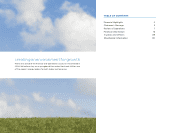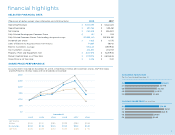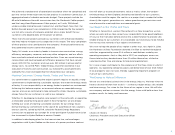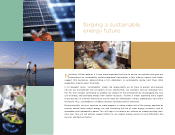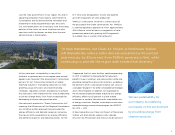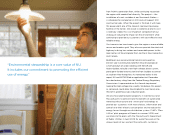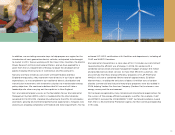Eversource 2008 Annual Report Download - page 9
Download and view the complete annual report
Please find page 9 of the 2008 Eversource annual report below. You can navigate through the pages in the report by either clicking on the pages listed below, or by using the keyword search tool below to find specific information within the annual report.
Like the state governments in our region, NU and its
operating companies have made a commitment to
sustainability and to demonstrating innovation and
leadership in reducing greenhouse gas emissions.
Our investment plans are in harmony with the energy
policies of the states we serve. And they are also
consistent with the themes we hear from the new
administration in Washington.
At the state level, sustainability is now at the
forefront as governments in our region have moved
aggressively to protect the environment. Connecticut
passed “An Act Concerning Connecticut Global
Warming Solutions” mandating reductions in state
greenhouse gas emissions and recommending
strategies, regulatory actions and policies to achieve
the reductions. New Hampshire has a law establishing
a Climate Change Policy Task Force responsible for
developing a climate change action plan.
Massachusetts enacted its “Green Communities Act”
requiring that 80 percent of the Regional Greenhouse
Gas Initiative auction proceeds be earmarked for
energy eciency and demand response; removing
the cap on utility expenditures on energy eciency
and demand response; and allowing utilities, for the
first time since deregulation, to own and operate
up to 50 megawatts of solar production.
WMECO’s solar power initiative is a direct result of
the passage of the Green Communities Act. WMECO
is seeking regulatory approval to invest approximately
$42 million to install at least six megawatts of solar
production, potentially growing to 50 megawatts,
at multiple sites in western Massachusetts.
If approved, the first solar facilities could be operating
in 2010. In addition to the potential for long-term
benefits to our customers and communities while also
providing competitive returns for investors, we believe
the elements of this solar power initiative can serve as
a valuable “blueprint” for other renewable technologies
across New England. In addition, we responded to
the increased funding available to bolster our energy-
eciency eorts by 67 percent in 2009 to help
customers in western Massachusetts make better use
of energy resources. We plan to develop a much more
expanded energy conservation program for WMECO
for 2010 — 2012.
In New Hampshire, our Clean Air Project at Merrimack
Station will dramatically reduce sulfur dioxide
emissions by 90 percent and mercury by 80 percent
We see sustainability for
our industry as redefining
our impact on the environment
by providing energy from
cleaner resources.
“In New Hampshire, our Clean Air Project at Merrimack Station
will dramatically reduce sulfur dioxide emissions by 90 percent
and mercury by 80 percent from PSNH’s generation fleet, while
continuing to provide the region with needed fuel diversity.”
8


